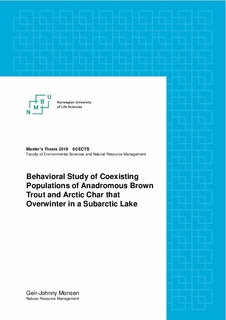| dc.contributor.advisor | Haugen, Thrond Oddvar | |
| dc.contributor.advisor | Kristensen, Torstein | |
| dc.contributor.advisor | Pedersen, Jan Karsten | |
| dc.contributor.author | Monsen, Geir-Johnny | |
| dc.coverage.spatial | Norway | nb_NO |
| dc.date.accessioned | 2019-12-18T10:15:57Z | |
| dc.date.available | 2019-12-18T10:15:57Z | |
| dc.date.issued | 2019 | |
| dc.identifier.uri | http://hdl.handle.net/11250/2633868 | |
| dc.description.abstract | This was an acoustic telemetry study on winter ecology and migratory behavior of anadromous brown trout (salmo trutta) and arctic char (salvelinus alpinus). The two species are coexisting in a subarctic lake of northern Norway called Botnvatnet. There is little research conducted on winterbehavior of these two species, and the aim of this study was to enlighten some of the secrets that were kept in the dark and cold life under the ice.
To get a better picture of the behavioral patterns 24 acoustic receivers were constantly logging signals from acoustic tags operated into the fish. There was a great difference in the habitat utilization between the two species. Arctic char utilized water at a median depth of 12-15 meters during the coldest months, while the brown trout stayed at 3-5 meters. Estimations of both swimming distance and home range size revealed that the arctic char was most active during the study period, swimming a median length of 30 kilometers each day. However, the brown trout showed that it also was surprisingly active with an average swimming distance of 20 kilometers a day. Some individuals of both species even swam an average distance of 70-80 kilometers each day for some months during the study. Parameter estimates of the most fitted models revealed that the factors species, sex, month and length was important influences on the habitat utilization. The effect of length had complicated interactions and varied from month to month between species and genders.
It is likely to believe, considering the activity level of the fish during the winter, that they were gaining energy in form of eating. All the tagged individuals survived the winter which indicates that wintering in freshwater may be beneficial and improve the survival rate of these salmonids.
The candidate fish was captured and tagged in their spawning river which ran into the lake on the south end. All the tagged individuals returned to the lake after spawning and utilized the lake as a winter refuge. Asspring unfolded a big part of the tagged individuals migrated to the sea. Parameter estimates of the most supported GLMsea-migration timing model predicted that increased water temperature (4°C) and raised water level (136 kPa) triggered the marine migration of the arctic char. There was not conducted a sea-migration model on the brown trout due to lack of individuals, but data on migration, water flow and water temperature (figure 4.8) strongly suggest the same pattern that were shown on the arctic char. The brown troutstarted the descend to the sea roughly two weeks (20.05.2016) before the arctic char (08.06.2016). | nb_NO |
| dc.language.iso | eng | nb_NO |
| dc.publisher | Norwegian University of Life Sciences, Ås | nb_NO |
| dc.rights | Attribution-NonCommercial-NoDerivatives 4.0 Internasjonal | * |
| dc.rights.uri | http://creativecommons.org/licenses/by-nc-nd/4.0/deed.no | * |
| dc.title | Behavioral study of coexisting populations of anadromous brown trout and arctic char that overwinter in a subarctic lake | nb_NO |
| dc.type | Master thesis | nb_NO |
| dc.subject.nsi | VDP::Landbruks- og Fiskerifag: 900 | nb_NO |
| dc.description.localcode | M-NF | nb_NO |

